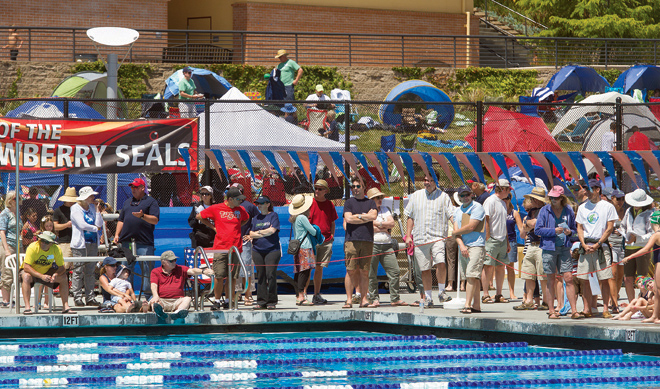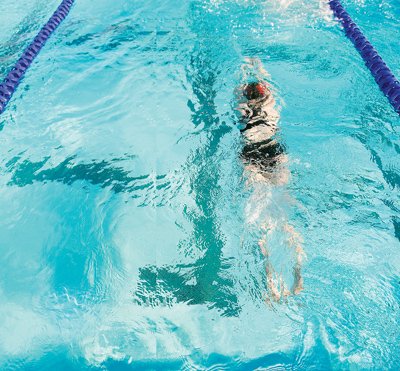IT’S A QUARTER past eight in the morning on this first Saturday in May, but veteran parents have already staked out the primo shady spots around the pool at San Rafael High, where the home-team Swimarin Sharks are about to take on the Rolling Hills Stingrays. It’s opening day of the 51st season of the Marin Swim League. Excitable girls are writing “Eat My Bubbles” on the backs of their friends. Parent volunteers are still working the bugs out. “Someone needs to help the people hanging the flags,” says one exasperated dad. “They don’t know what they’re doing.”
“You better round up your relay,” a stressed mother is telling her teenage son, whose pronounced bed-head and catatonic expression suggest he was asleep as recently as 15 minutes ago. “They’re gonna start pretty soon!”
On the other side of the pool, beneath the huge “Shark Warning” sign, Laura Nagel and her 8-year-old daughter Elise are engaged in a tense negotiation that is being played out at MSL meets all over the county this morning:
“No, not a doughnut. How about a bagel?”
The MSL consists of 10 teams and roughly 1,400 swimmers. The vast majority of those youngsters don’t go on to swim in college. Many won’t even swim for their high school teams. They are practicing, on average, three times a week because their friends are doing it, because they love the camaraderie and competition and field trips. They’re also doing it thanks to a tiny nudge from their parents, who enjoy the company of the other parents.
“I came to see the meets as a kind of enforced relaxation,” says Michael Dubois, whose sons Keenan and Lucas swim for Sleepy Hollow. “You work your ass off all week, then come to the pool and hang out with a bunch of people you really like.” For a long time, his phone couldn’t get a signal at the Sleepy Hollow Pool. “And that was a good thing.”
While scratching a social itch, MSL parents are also giving their children a huge gift: a lifetime of water safety skills.
“My husband surfs, we spend a lot of time around the water, so that was our first goal, for our kids to be strong, confident swimmers,” Nagel explains at the Swimarin/Rolling Hills meet, moments before young Elise walks triumphantly past, bearing a glazed doughnut the size of a life preserver.

page: |
1 |
| |
2 |
| |
3 |
| |
4 |
| |
5 |





